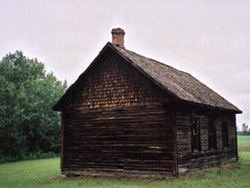Germaine Guèvremont

Germaine Guèvremont (née Grignon) was born in 1893 in Saint-Jérôme, Quebec, to a father who was a lawyer and a mother who was a painter. A lover of nature and poetry at a young age, Germaine devoted her evenings to writings and used the pseudonym "Nature" to sign her work. Germaine studied all over the province of Quebec, as well as in Toronto, where she learned English and the piano. When she returned to Quebec, she published in a variety of women’s magazines. Through her family, however, she met several authors and artists who would influence her development as a writer. She was also the cousin of Claude-Henri Grignon, the author of the influential novel, Un homme et son péché.
In 1914, Germaine met Bill Nyson, a journalist from Montreal who was the son of a Norwegian minister and who had studied in China. He had been sent to cover a legal trial that her father was involved in. Although Bill eventually ended up marrying Germaine’s sister, Jeanne, he remained an important literary influence and helped her career as a journalist. It is also believed that Bill became the inspiration for her fictional character "le Survenant".
In 1916, Germaine married Hyacinthe Guèvremont and moved to Sorel. She took 10 years off from writing in order to raise a family. But when one of her daughters died in 1926, she slipped into a deep depression. Bill Nyson encouraged her to take a job writing for The Gazette in Montreal. She eventually took over as Editor-in-Chief of the local newspaper Courrier de Sorel. She began to look at her surroundings in a new light, paying particular attention to both the natural surroundings and the social conditions of the region where she lived.
The Depression forced the Guèvremonts to move to Montreal, where Germaine took a job as a court stenographer. She once again began to write for local women’s magazines, and her short stories would eventually be published under the title En pleine terre. In 1945, she would publish Le Survenant and its sequel in 1947 Marie-Didace. Both novels would appear together in English as The Outlander. The novels were a huge commercial and critical success, winning both a Governor-General’s Award and a medal from l’Académie canadienne-française, and were later adapter for TV by Radio-Canada.
In 1957, Germaine and her husband moved to a cabin on l’îlette au Pé where Germaine continued writing articles, short stories and scripts for movies and television. L’Adieu aux îles was televised on Radio-Canada in 1968, the same year Germaine was hospitalized. On August 21, 1968 at the age of 75, Germaine Guèvremont passed away. Her two novels are often sighted as the "last" of the roman de terre, or novels of soil, a genre that dominated Quebec literature for almost 100 years. While the novels stay closely within the rules of the genre, evidence of the social reality of the Depression, the war and the decline of the rural way of life is also prominent. These books can also be read as pre-feminist texts, questioning the traditional roles and limitations placed on women by Quebec society. (Lee Skallerup)
- Germaine Guèvremont’s "Marie-Didace" (in English)
- Germaine Guèvremont (1893-1968): Includes links to short critical introductions to her three main works
- Wikipedia bio (French)
Updated February 12 2015 by Student & Academic Services